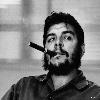

Topics: Entertainment Tags: Che Guevara View |
Tags: Che Guevara View |
Tags: Che Guevara View |
|||||||||
Ernesto "Che" Guevara (IPA-es?t?e ge??a?a; June 14, 1928 - October 9, 1967), commonly known as El Che or simply Che, was an Argentine (Argentina) Marxist (Marxism) revolutionary, physician, author, intellectual, guerrilla leader, diplomat, military theorist, and major figure of the Cuban Revolution. Since his death, his stylized visage has become a ubiquitous countercultural (counterculture) symbol and global insignia within popular culture (Che Guevara in popular culture).
As a young medical student, Guevara traveled throughout Latin America and was transformed by the endemic poverty he witnessed. His experiences and observations during these trips led him to conclude that the regions ingrained economic inequalities (Economic inequality) were an intrinsic result of monopoly capitalism (state monopoly capitalism), neocolonialism, and imperialism, with the only remedy being world revolution. This belief prompted his involvement in Guatemalas social reforms under President Jacobo Arbenz Guzm�n, whose eventual CIA-assisted overthrow (1954 Guatemalan coup d�tat) solidified Guevaras radical ideology. Later, while living in Mexico City, he met Ra�l (Ra�l Castro) and Fidel Castro, joined their 26th of July Movement, and invaded Cuba aboard the yacht, Granma (Granma (yacht)), with the intention of overthrowing U.S. (United States)-backed Cuban dictator Fulgencio Batista. Guevara soon rose to prominence among the insurgents (Insurgency), was promoted to second-in-command, and played a pivotal role in the successful two year guerrilla campaign that deposed the Batista regime.
Following the Cuban Revolution, Guevara performed a number of key roles in the new government. These included reviewing the appeals and firing squads (Execution by firing squad) for those convicted as war criminals during the revolutionary tribunals, instituting agrarian reform (Agrarian Reform Laws of Cuba#First agrarian reform law under Che Guevara) as minister of industries, serving as both national bank president and instructional director for Cuba?s armed forces, and traversing the globe as a diplomat on behalf of Cuban socialism. Such positions allowed him to play a central role in training the militia forces who repelled the Bay of Pigs Invasion and bringing to Cuba the Soviet (Soviet Union) nuclear-armed (Nuclear weapon) ballistic missiles which precipitated the 1962 Cuban Missile Crisis. Additionally, he was a prolific writer and diarist, composing a seminal manual (Guerrilla Warfare (book)) on guerrilla warfare, along with a best-selling memoir about his youthful motorcycle journey (The Motorcycle Diaries) across South America. Guevara left Cuba in 1965 to incite revolutions, first unsuccessfully in Congo-Kinshasa and later in Bolivia, where he was captured by CIA (Central Intelligence Agency)-assisted Bolivian forces and executed.
Guevara remains both a revered and reviled historical figure, polarized in the collective imagination in a multitude (Additional materials on Che Guevara) of biographies, memoirs, essays, documentaries, songs, and films. Time (Time (magazine)) magazine named him one of the 100 most influential (Time 100: The Most Important People of the Century) people of the 20th century, while an Alberto Korda photograph of him entitled Guerrillero Heroico (Che Guevara (photo)) (shown), was declared "the most famous photograph in the world."
Date of birth: 1928-06-14
Birth Location: Rosario, Santa Fe, Rosario, Argentina
Date of death: 1967-10-09
Death Location: La Higuera, Bolivia
Religion: None
Organizations: 26th of July Movement, United Party of the Cuban Socialist Revolution, National Liberation Army (Bolivia)



